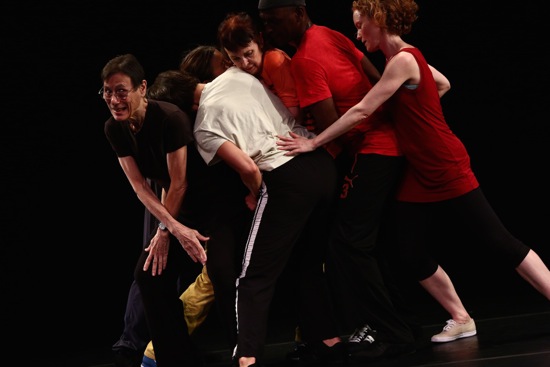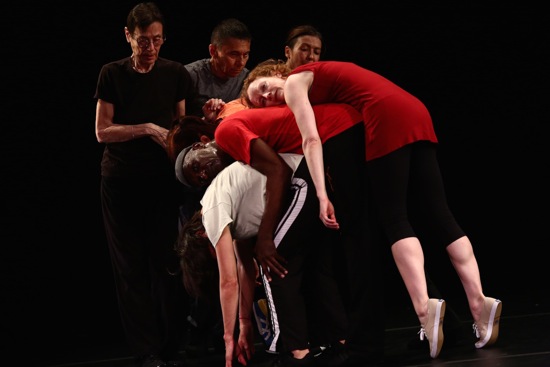Yvonne Rainer’s The Concept of Dust: Continuous Project—Altered Annually.

Yvonne Rainer’s The Concept of Dust: Continuous Project—Altered Annually. (L to R): Yvonne Rainer, Patricia Hoffbauer, Emmanuèle Phuon, Pat Catterson, David Thomson, and Emily Coates. Photo: Paula Court
So, a woman walks into The Kitchen and stands hesitantly before the audience. Behind her, at the back of the performing area, five dancers wait; there’s a gap in their shoulder-to-shoulder line. The woman—it is choreographer Yvonne Rainer— warns us, fumbling a bit for words, that she has bad news for us. About performer Pat Catterson. Then she delivers it: “Pat died.” Cries erupt from the audience as she talks on: “Oh no!” “Not Pat!” and the like. That’s what the gap in the line of performers tells us: Catterson, the eldest of the performers and Rainer’s choreographic assistant in The Concept of Dust: Continuous Project— Altered Annually, is missing. Oh my God.
In the midst of our consternation, Catterson strides onto the stage, calling out: “What the fuck, Yvonne! Are you trying to get rid of me?” The other performers rush away in a horde, arms thrown up, shrieking as if they’ve seen a ghost. Rainer remains calm and not exactly apologetic; she exits, leaving the space to Catterson, who begins a solid, soft-shoe routine while delivering the first text of the evening (drawn from a New Yorker review by Joan Acocella of Brian Seibert’s book, What the Eye Hears: a History of Tap). She tells most memorably of slave ships, whose captives were regularly brought up on deck and ordered to dance, in the hope that exercise would keep them healthy.
At the end of the work, after the bows, Rainer returns to the stage and wonders if we have any questions. Especially about that beginning. Opinions vary. Is that kind of a jolt good for us? Might there be a less alarming way of reminding us that we will all become dust some day? One choreographer said afterward that she thought Rainer’s opening—risky as it was—was a strong one, even though she admitted to seeing the first ten minutes of Dust through tears.
The work didn’t have this shocking opening when a version of it premiered last June at the Museum of Modern Art under the title, The Concept of Dust, or How do you look when there’s nothing left to move? It acquired the new title when it began this five-week series of presentations by the American Dance Institute, produced by Performa, and co-commissioned by the Getty and Performa. This month, ADI breaks ground on a new structure in Catskill, New York, where selected choreographers will have not only studios in which to create, but a black-box theater. Still to premiere during The Kitchen season are works by Brian Brooks, Jane Comfort, Susan Marshall, and Jack Ferver.
Certainly, age is a factor in Rainer’s Dust. She was born in 1934. None of the marvelous performers is young, although all are youthful. Emily Coates, Patricia Hoffbauer, Emmanuèle Phuon, Keith Sabado, David Thomson, and Catterson bring a treasury of experience to their work in Dust—dancers and choreographers able to make smart decisions about what sequences or movements to choose in the parts where that is an option.
There’s something relentless about the verbiage, which raises issues that don’t always seem to relate to what we see—at least, not in obvious ways. Rainer hauls a script around, holding it in front of now this performer, now that one (whether he/she is busy with some dancing or resting on the floor) and offering the microphone. The script is cumbersome, and pauses for page turning are frequent. Rainer’s manner strikes a medium between offering her colleagues a chance to speak up and badgering them to do so.
The dynamics of Dust make me think of Rainer’s epochal 1966 Trio A. For that, she choreographed a vocabulary of fascinating, apparently unrelated movements, never repeating them (even though she executed a few of them several times in a row), but spooling them out in a matter-of-fact flow that had much in common with daily life (e.g. brush your teeth, scratch a sudden itch, pause to remember a friend’s remark, rinse out your mouth, pick up a sock you notice on the floor).

Yvonne Rainer’s The Concept of Dust: Continuous Project—Altered Annually. (L to R) back row: Yvonne Rainer, Keith Sabado, Emmanuèle Phuon; pileup: Patricia Hoffbauer, David Thomson, Pat Catterson, and Emily Coates. Photo: Paula Court
Your gaze travels around the space, unconsciously tracking memories. Sabado catches my eye, jiggling around, giggling in silent pleasure at something he feels or remembers. Later, I spot Phuon doing her version of this. You welcome back the sight of people running in a circle, occasionally bounding into a low-level leap. A skilled choreographer is at work here. The dancers may fall into unison or divide into counterpoint—giving equal emphasis to movements as different as a waddle with turned-out feet, curved arms lifting to frame the face, and the swing of a leg into the air. Rainer may read aloud while lying on her belly or sitting on the butt of one of the several crawling dancers—as unconcerned about her mount as a colonizer seated atop an elephant.
Coates—hands pinioned behind her back, crawling forward on her knees, and convulsing in anguish—tries to bring to life Carl Van Vechten’s stilted description of Isadora Duncan depicting the Russian slave’s emergence into freedom (one of Duncan’s works to the music of Scriabin). She ends by flinging her arms wide. Pretty soon two others join her to replay the whole sequence, which bears little resemblance to the version of the solo handed down by Irma Duncan. A flawed recollection drawn from words. A fossil uncovered from its dusty demise—albeit a different sort from the remains of a tiny, 52 million-year-old hedgehog unearthed by anthropologists (an account read early in Rainer’s piece) a couple of years ago.
Some of the available movements and images come from Rainer’s own history. The group collaborates to lift Thomson, place a pillow to receives his head, and lower him onto it. This refers to a section of Rainer’s Continuous Project Altered Daily (1970 at the Whitney). I thought I also caught a two-handed gesture close around the head that I recall from Trio A. One of the texts is a very bad dream of hers.
Those texts—some of them fairly long, others pithy—swarm around my head. I want to catch them all and can’t. I know they’re connected. Something about Mohammed and the Abbasid dynasty; the controversial interpretation of the Second Amendment on well-regulated militias; the widow of Isaac Babel, who lived to be 101; Oreo, Fran Ross’s satirical 1974 novel about a racially mixed young woman; incidents of violence and racial profiling. A few of these come out of thin air, trailing absurdity, e.g. “It is better to have loved and lost than to have put linoleum on your floor” (although, come to think of it. . .) .
The overall rhythm of the words and the delivery system that butts against movement creates the sense that Rainer and her interloping microphone represent politics and history nudging at the dancing, as if to say, “Wake up to the world!” And “Look at what’s been happening around us.”
Once she asks, “Where is that music coming from?” and, indeed, what must be Gavin Bryar’s Sinking of the Titanic sounds as distant and unearthly as the echo of the ship’s band heard through water. Not long after that, we hear the dazzling resurrection by Cecilia Bartoli of an aria from the turn of the 18th century, Giovanni Paisiello’s “Chi vuol la Zingara.” Just before that, and again later, the performers cluster and sing wordlessly the first four notes of “We Shall Overcome” (omitting the drop onto what would be the “come” tones).
Two passages stand out, both of them signaled by Rainer. “Crush,” she calls, and they all cluster tightly together—struggling to stay connected, even thought the whole group travels across the space, even though individuals fall out of it and are drawn back. Later, she decides on “Slow” and trios take turns coming forward and slowly working their way into a position. For example, facing the audience, Sabado, Catterson, and Thomson bend forward and then reconstitute themselves, ending with Sabado holding Thomson’s feet, while the latter braces himself on one shoulder, and Catterson and Sabado lean together. Variations and repetitions of this ensue, with the participants walking forward to take a turn.
And, lest anyone think otherwise, they all dance strenuously and diligently, but calmly (unless you count Hoffbauer’s crazy fit in a bright-patterned skirt she has donned, perhaps disguised as Henri Rousseau’s “Sleeping Gypsy”). And the program lists names of those from whom Rainer has sourced movement. They include Fritz Lang, Jacques Tati, Honi Coles, and Nina Stroganova. All of them are dust, and they still live among us.

Thanks for that, Deborah. You astutely selected the gems in Dust. And knitted it all together with your final line.
In gratitude and appreciation, Yvonne
While I haven’t seen much of Rainer’s work, I have all her books and saw her films. Her vacuum cleaner piece (what I call it) performed at the Museum of Fine Arts in boston in late 60s or early 70s was definitely a factor in my unwilling but necessary move to New York City, along with Barbara Lloyd and Steve Paxton subbing for my modern dance teacher Claire Mallardi. The three of them made me realize I could take dance seriously without having to be in a company, definitely not one of my “callings.”
I loved Rainer’s memoir, Feelings Are Facts, and was surprised to learn how close she was to Pat Catterson in that book. Pat Catterson lent us her Broadway loft in 1975-76 so we could study with Charles Honi Coles and Charles Cookie Cook, and 4 of us student hoofers swooned over “the fastest feet in show business” (Coles) and the gorgeous routines Cook taught us. We stared unbelievingly at these underused great feet and marveled at our good fortune. Coles had a good laugh when I said we’d pay what we paid for modern classes at the time, $3.50. Honi left with a whopping $15.00 to and from long rides in Elmhurst, Queens. Pat’s floor WAS linoleum but it didn’t matter. The sounds of jazz tap just seeped right into us. And somehow she was always modern or postmodern and how did she hook up with Rainer?
I recently momentarily reunited with Pat to give her my memoir since in it Honi Coles referred to her always as “Pretty Pat.” Oh, how I wish I remembered Pat telling me in my apartment two months ago that she would be dancing with Rainer in June. What another great title: “The Concept of Dust”. Rainer can really write, as much as she is known for dancing and filmmaking.
So bummed I missed this one. But thanks Deborah for your powerful consistency in recording these performances. Yes, I fell asleep completely at the last concert I saw you at (and sat next to you; and maybe even snored). But I bet it wouldn’t have happened at “The Concept of Dust.” I think the title of the Boston piece was “Story about a Woman Who…..” and so what if facts are not feelings and I get her titles wrong. Rainer is one of our people who make you want to go out and move…….mountains.